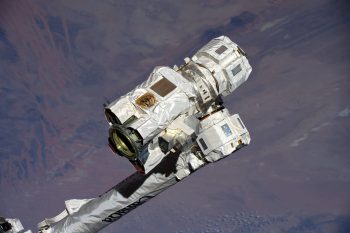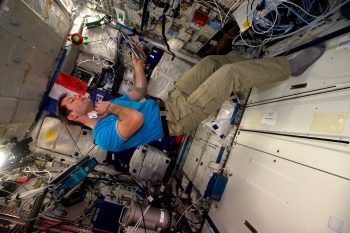Third week in space
What is Thomas Pesquet doing on the International Space Station? Here are the details for last week and a look at the highlights for this week. Almost every day in space for all astronauts involves at least 90 minutes of exercise to keep fit and daily planning conferences with ground control, these will not be mentioned every time.
Monday 5 December

EveryWear’s Biometric patch. Credits: ESA/NASA-Thomas Pesquet
Thomas started the week installing two acoustic dosimeters on Commander Shane and Sergei Ryzhikov who wore them for 24 hours to chart how noisy the International Space Station is. Thomas took a refresher course at installing new software on the Station’s exercise machine ARED for later and then started wearing his EveryWear patch that will record his temperature and monitor activity levels. He then helped Peggy Whitson take ultrasound images of her arteries for the Cardio Ox Ultrasound experiment. When that was finished Thomas used a tablet-tool to assess his health for flight surgeons on Earth. He spent two hours rerouting a power cable before exercising and then lunch.

The Canadarm robotic arm that will be used to catch and bert the HTV. Credits: ESA/NASA-Thomas Pesquet
The afternoon was spent with Shane preparing for the robotic berthing of the Japanese HTV cargo ship that is scheduled to arrive 13 December with supplies.
Tuesday 6 December
After being worn for 24 hours Thomas retrieved the acoustic dosimeters from Shane and Sergei and set two new dosimeters on Andrei Borisenko and himself for a new round of 24-hour recording sound levels. Thomas did another session on Fine Motor Skills and charged and checked the EveryWear patch for use. He spent almost the whole morning cleaning the duct of the Station’s smoke detector until lunch. After lunch Thomas had his live event with the Académie des sciences in France talking to schoolchildren live. The afternoon was spent practicing with Shane with the Station’s robotic arm for HTV berthing and exercise before bed.
Wednesday 7 December

Thomas using EveryWear’s tonemeter. Credits: ESA/NASA-Thomas Pesquet

Thomas working on the Robotics External Leak Locator in Kibo. Credits: ESA/NASA-Thomas Pesquet
On waking up Thomas filled in a questionnaire into the EveryWear app on his sleep patterns before the morning conference with ground control. Afterwards he collected the two dosimeters in use and put two new ones on Peggy and his Soyuz commander Oleg Novitsky. Thomas then spent four hours working in the Japanese laboratory Kibo preparing the Robotic External Leak Locator demonstration that aims to sniff out leaks on the outside of the Space Station for monitoring and diagnostics. Thomas prepared the mini-airlock and put the experiment inside, depressurised the airlock and sent it outside. Before lunch Thomas had time to use EveryWear’s Tonomoter function to record how his arteries are adapting to weightlessness and his monthly meeting with ESA mission directors.
The afternoon was spent training for HTV and exercising.
Thursday 8 December
Thomas started the day again with a questionnaire on his sleep patterns. After the morning conference Thomas had urine duties – he had to transfer the collected urine to the waste storage. He spent some time organising bags in Columbus and Kibo laboratories and worked with EveryWear to check the system was working as planned. He also retrieved the dosimeters from Peggy and Oleg and sent the data to ground control for analysis. A large part of the morning was spent on the Vascular Echo study looking at astronauts’ cardiovascular health.

EveryWear’s smartshirt kit. Credits: ESA/NASA-Thomas Pesquet
After lunch Thomas worked some more with the waste water took some blood samples, had a quick radio contact with a school in St Malo, France, and finished the day with exercise. He spent almost an hour on the Station’s exercise bike but wore the EveryWear smartshirt that recorded his heartbeat throughout the session as an extra monitoring tool. Before finishing the day had a private conference with family and downloaded the EveryWear data to the French user operations centre CADMOS in Toulouse.
Friday 9 December
Thomas did some another Fine Motor Skills session and took some more blood samples of himself and stored the samples in the Station’s freezers. He changed a gas bottle on ESA’s European electroMagnetic Levitator and retrieved two more acoustic dosimeters that had been installed on the Station to send the data for analysis.

European ElectroMagnetic Levitator. Credits: ESA
Over the last week the Electromagnetic Levitator processed Aluminium Nickel samples under Argon atmosphere and samples of NdFeB under helium atmosphere. This facility runs without much intervention of an astronaut and process metals to melt and solidify them in mid-air – allowing scientists on Earth to understand the finer points of metallurgy of alloys without gravity influencing the data.
In the afternoon Thomas took a Doppler echo scan of his leg for the Vascular Echo experiment and did a monthly inspection of the Station’s treadmill before using it for his exercise routine.
This week
Highlights for Thomas this week include working on the European Biolab facility, catching and berthing HTV on Tuesday with Shane.
He will also do some eye examinations, another Aquapad session, test AquaMembrane as a new way of filtering the Station’s water and work on the Space Station’s space suits.





Discussion: one comment
Bonjour Thomas,
Je sais que vous êtes bien occupé mais j’ai une faveur à vous demander: pourriez-vous nous dédicacer une photo, équipe ou Espace, pour nos 25 ans de mariage le 28 décembre ? Merci ! Isabelle